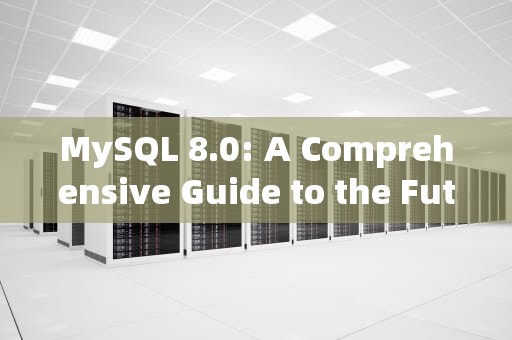In the ever-evolving landscape of database management systems, MySQL has long been a stalwart, providing robust, reliable, and scalable solutions for developers and enterprises alike. With the release of MySQL 8.0, the open-source relational database management system (RDBMS) has taken significant strides forward, introducing groundbreaking features that elevate its performance, security, and usability. This comprehensive guide delves into the key aspects of MySQL 8.0, exploring its new capabilities, improvements over previous versions, and how it continues to shape the future of data management.

Introduction to MySQL 8.0
Released in April 2018, MySQL 8.0 marked a milestone in the history of the popular RDBMS. It brought about a plethora of enhancements across various domains, including performance optimization, JSON support, window functions, common table expressions (CTEs), role-based access control, and more. These advancements not only address the growing demands of modern applications but also pave the way for seamless integration with cloud environments and advanced analytics.
Key Features and Enhancements
1、Performance Boosters: MySQL 8.0 introduces several performance-enhancing features, such as the InnoDB Cluster, which simplifies high availability and disaster recovery setups. The cluster architecture ensures automatic failover and data replication, minimizing downtime and enhancing data durability. Additionally, the rewritten SQL parser accelerates query execution by optimizing plan generation and reducing latency.
2、Enhanced JSON Support: Recognizing the increasing prevalence of semi-structured data, MySQL 8.0 significantly enhances its JSON capabilities. Users can now create virtual columns based on JSON data, enabling efficient indexing and faster retrieval. The new JSON_TABLE function allows for easy transformation of JSON documents into relational tables, facilitating complex queries on nested structures.
3、Window Functions and Common Table Expressions (CTEs): These additions bring MySQL closer to the functionality offered by other high-end databases like PostgreSQL and SQL Server. Window functions enable calculations across a set of table rows that are somehow related, making them ideal for analytical queries. CTEs, on the other hand, provide a way to define temporary result sets within a query, enhancing code readability and reusability.
4、Role-Based Access Control (RBAC): Security is paramount in any database system, and MySQL 8.0 strengthens its defenses with the introduction of RBAC. This feature allows administrators to define roles with specific privileges and assign these roles to users, simplifying permission management and enhancing security compliance.
5、Data Encryption and Auditing: To further bolster security, MySQL 8.0 offers native encryption for data at rest and in transit. The Data at Rest Encryption feature automatically encrypts all database files, while the Encrypted Protocol ensures secure communication between clients and servers. Moreover, the enhanced auditing capabilities allow for detailed logging of user activities, aiding in compliance and forensic investigations.
6、Improved Performance Schema: The Performance Schema, a tool for monitoring server performance, has been revamped in MySQL 8.0. It now provides deeper insights into query execution, helping developers identify bottlenecks and optimize their applications more effectively.
7、Support for NoSQL Data Models: Acknowledging the rise of NoSQL databases, MySQL 8.0 introduces support for document store and key-value pair storage through the JSON data type and the new JSON_EXTRACT and JSON_REPLACE functions. This flexibility allows developers to leverage both SQL and NoSQL paradigms within a single database system.
Backward Compatibility and Upgrade Path
One of the critical considerations when adopting a new version is ensuring compatibility with existing systems and smooth upgrade paths. MySQL 8.0 maintains extensive backward compatibility with earlier versions, allowing for incremental upgrades without disrupting ongoing operations. However, organizations should carefully review the documentation and test thoroughly in a staging environment before deploying to production.
Integration with Modern Technologies and Ecosystems
MySQL 8.0's advancements make it well-suited for integration with modern technologies and ecosystems. Its support for JSON, window functions, and CTEs facilitates seamless interaction with big data platforms and analytics tools. Furthermore, its compatibility with containerization technologies like Docker and orchestration frameworks like Kubernetes enables effortless deployment and scaling in microservices architectures.
Community and Enterprise Editions
MySQL is available in two primary editions: the open-source Community Edition and the commercially supported Enterprise Edition. While the Community Edition provides a robust set of features suitable for many use cases, the Enterprise Edition adds value with additional tools for backup, replication, monitoring, and consulting services. Organizations can choose the edition that best fits their needs and budget.
Conclusion
MySQL 8.0 represents a significant leap forward in the evolution of relational database management systems. Its innovative features address contemporary challenges in data management, from handling large-scale datasets to ensuring data security and compliance. By embracing advancements in performance, security, and usability, MySQL 8.0 solidifies its position as a leading choice for developers and enterprises seeking a powerful yet flexible database solution. As technology continues to advance, MySQL's commitment to innovation ensures that it will remain at the forefront of the database landscape, empowering businesses to harness the full potential of their data assets.
随着互联网的普及和信息技术的飞速发展台湾vps云服务器邮件,电子邮件已经成为企业和个人日常沟通的重要工具。然而,传统的邮件服务在安全性、稳定性和可扩展性方面存在一定的局限性。为台湾vps云服务器邮件了满足用户对高效、安全、稳定的邮件服务的需求,台湾VPS云服务器邮件服务应运而生。本文将对台湾VPS云服务器邮件服务进行详细介绍,分析其优势和应用案例,并为用户提供如何选择合适的台湾VPS云服务器邮件服务的参考建议。

工作时间:8:00-18:00
电子邮件
1968656499@qq.com
扫码二维码
获取最新动态
